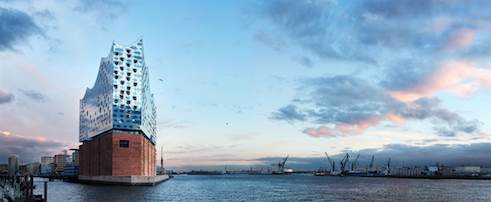German cultural and educational policy
Ensuring freedom in the arts

From subculture in the backyard to high culture in the opera house – with its diverse cultural scene, Germany caters to a wide variety of cultural preferences. But how exactly is Germany’s colourful cultural landscape funded?
Hamburg’s new, 800 million-euro Elbphilharmonie, the Museuminsel Berlin, and Semperoper Dresden are just a few examples of Germany’s cultural richness, were richness is meant quite literally. With its diversity and density, the German cultural landscape covers a wide variety of cultural preferences. But how exactly is Germany’s colourful cultural landscape funded?
Monika Grütters, Federal Government Commissioner for Culture and the Media from 2013 to 2017, explains the principle of German state support for culture: “It is not the remit of politics to plan culture, but rather to ensure its freedom.” Grütters is referring to the guarantee of artistic freedom set out in the German constitution. It provides state protection of artistic autonomy through government funding of art and culture to safeguard them from free-market constraints. It does not, however, prohibit private support from companies, creating an interplay between public and private support for the arts and culture in Germany.
State support of the arts
Germany leads the world in state cultural funding. According to the Culture Finance Report, public sector financing amounted to 9.9 billion euros in 2016, only 17 percent of which came from the highest, federal level. The German funding landscape is unique for its decentralized organisation based on the concept of the “cultural sovereignty of the states”. Germany’s federal states and municipalities are responsible for setting cultural and educational policy and manage their own cultural budgets. The federal government is only responsible for promoting culture abroad and in affairs of state. In 2016, cities and municipalities accounted for the largest share of cultural expenditures with 45 percent compared to the states’ 40 percent contribution.
There are pros and cons to this decentralized structure. As a rule, the federal states allocate funding primarily for projects inside their territory, which impacts the range of art and culture on offer. According to Birgit Mandel, a professor of cultural mediation and cultural management at the University of Hildesheim, each federal state tends to promote and build on its own representative cultural sites. While this is not entirely unproblematic, it can also have positive effects. It creates competition that has resulted in great cultural diversity clearly visible in the sheer number of museums, theatres and orchestras that flourish throughout Germany. Worldwide, one forth of all professional orchestras are in Germany, Mandel said in an interview with goethe.de/kultur.
Government support for the arts in Germany goes beyond direct budget expenditures as well. Freelance artists, for example, only have to pay the employee’s share of usually around 50 percent into the Künstlersozialkasse – a social security scheme created especially for artists. The state and companies cover the other half.
 Hamburg’s new, 800 million-euro Elbphilharmonie, is just one example of Germany’s cultural richness.
| Photo: Elbphilharmonie © Maxim Schulz
Additionally, the government offers tax breaks for private organisations such as companies or foundations that promote culture, a type of indirect state support for the arts. Since the beginning of the 20th century, Germany has given incentives to private companies interested in fostering culture, so as to make them more attractive to employees, for example. Today, companies support the arts through foundations, sponsoring, and donations. Private sector investment in culture is motivated in part by a sense of corporate social responsibility, but one primary driver has always been the boost it gives a company’s reputation. Large companies see themselves as ‘corporate citizens’ and thus as civil society stakeholders. Incidentally, companies also prefer to fund projects in the respective region around their local offices or plants.
Hamburg’s new, 800 million-euro Elbphilharmonie, is just one example of Germany’s cultural richness.
| Photo: Elbphilharmonie © Maxim Schulz
Additionally, the government offers tax breaks for private organisations such as companies or foundations that promote culture, a type of indirect state support for the arts. Since the beginning of the 20th century, Germany has given incentives to private companies interested in fostering culture, so as to make them more attractive to employees, for example. Today, companies support the arts through foundations, sponsoring, and donations. Private sector investment in culture is motivated in part by a sense of corporate social responsibility, but one primary driver has always been the boost it gives a company’s reputation. Large companies see themselves as ‘corporate citizens’ and thus as civil society stakeholders. Incidentally, companies also prefer to fund projects in the respective region around their local offices or plants.
Private investors versus state support
Not everyone approves of the leading role the German state plays in fostering culture. Some critics point out that excessive state interference could undermine freedom in the arts, while others emphasize that public support may make artists feel more indebted to society.
But the alternative – an increase in corporate support for arts and culture – is also a double-edged sword. If cultural institutions were completely privatised and funding depended on a cost-benefit analysis, many might be forced to close their doors.
In terms of content, substantial state backing results in a focus on conventional, middle-class high culture. Institutions like opera houses and theatres with their high human resource costs claim the majority of the funds, up to 95 percent in some federal states. Subcultures and new currents and art forms, on the other hand, often report that they are overlooked and neglected. In an interview with goethe.de/kultur, cultural and media expert Norbert Sievers explained that the German funding system “created a marked conservatism in the cultural infrastructure on the one hand. Conventional art forms take priority, and anything novel must fight the establishment to be given a turn.” On the other hand, the high level of funding major cultural institutions received at times exceeded state capacity. In the meanwhile classical high culture is losing relevance for an ever-growing segment of the population. Only about ten percent of people – primarily academics with a higher social status – visit cultural institutions such as concert halls, theatres and museums.
Another major difference between public and private funding of the arts is the time frame. Government budgets often have to be renegotiated on an annual basis, whereas private foundations can invest more long term.